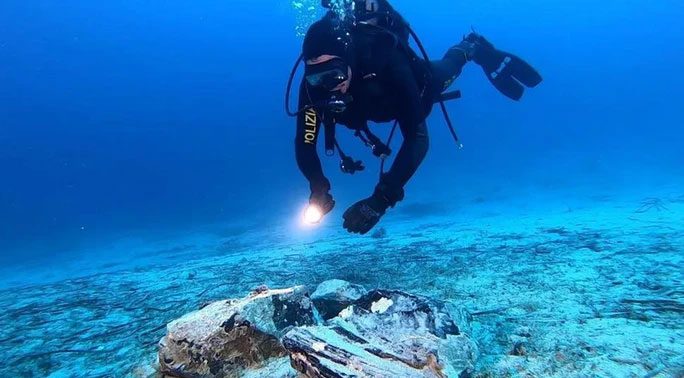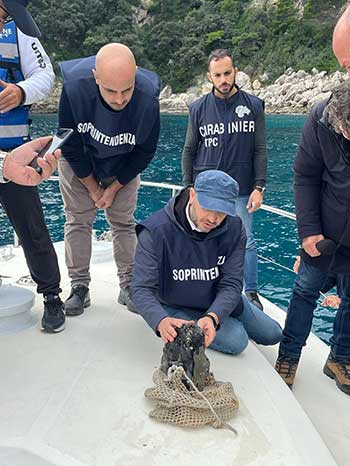The obsidian block is among the cargo of a Neolithic cargo ship that could be used to create sharp tools.

Diving teams recover the obsidian block from the seabed near Capri Island, Italy. (Photo: Naples Superintendency for Archaeology, Fine Arts and Landscape)
A team of divers from the underwater unit of the Naples Police in Italy retrieved a block of obsidian, also known as volcanic glass, from the wreck of a Neolithic ship (circa 7000 – 2000 BC) near Capri Island, as reported by Live Science on November 22.
This natural glass block was recovered from the seabed at a depth of 30 – 40 meters on November 20. The block is roughly the size of a large book and weighs about 8 kg. The surface of the block shows clear signs of being chipped. Archaeologists believe this to be a core of obsidian that could be used to create sharp pieces for tool-making.

The obsidian block may be a “core” for producing sharp-edged pieces used as stabbing and cutting tools. (Photo: Naples Superintendency for Archaeology, Fine Arts and Landscape).
The divers discovered the wreck site earlier this year and reported it in October, but did not disclose the exact location to protect the wreck from thieves. The obsidian core is the first artifact retrieved from the wreck, but experts expect to find more similar stones in the area.
Archaeologists believe that the newly recovered stone is part of the cargo of a cargo ship that operated during the Neolithic period, over 5,000 years ago. However, they cannot locate the ship itself as the wood has likely decomposed over such a long period.
The wreck lies in relatively deep waters, making research and recovery processes challenging, the archaeological team noted. The obsidian block is currently being preserved in Naples and will soon undergo cleaning, examination, and conservation.
Obsidian is a black glass found in cooled lava. It fractures into sharp-edged pieces, which ancient people commonly used to make cutting and piercing tools.
Experts are still unclear about the origin of the newly discovered obsidian block, but deposits of this stone are present on several volcanic islands in the Mediterranean, including Palmarola Island near Naples and Lipari Island near Sicily. Maritime archaeologist Sean Kingsley mentioned that the block may have been used for trade or crafting ritual objects, similar to the artifacts from the Neolithic period found in the Grotta delle Felci cave in Capri.

















































